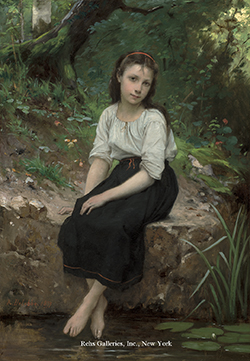BIOGRAPHY - Francois Alfred Delobbe (1835 - 1920)
François Alfred Delobbe was a successful naturalist painter working in the last half of the nineteenth century. Born in Paris in 1835, Delobbe entered the Ecole des Beaux-Arts at the age of 16; such a young age for admission to the prestigious school suggests that he must have demonstrated significant talent as a young student. He began his instruction with Thomas Couture, the academic painter of historical genre scenes who also taught Edouard Manet from 1850-1856. Certainly the two novice painters, only three years apart in age, would have known each other from this time. Although Delobbe remained within the academic mainstream of contemporary French painting, an early work such as The Young Knitter of 1867, hints at a modest influence from his famous former classmate. Like so many of Manet’s paintings from the 1860s, this work is basically a study in black and white with a touch of bright red in the basket of yarn at the young woman’s feet. Similar too is the influence of seventeenth-century Spanish and Dutch painting as well as the ambiguous expression on the model’s face. The viewer is left to wonder whether she is sad or lonely or simply bored; Delobbe offers no easy sentimental commentary.
Delobbe continued his studies in the studio of William-Adolphe Bouguereau, who encouraged him to focus on mythological scenes and portraiture. In 1861, he debuted at the Salon des Artists Français with a portrait of his mother that received positive critical response in the Parisian press. Throughout the 1860s, Delobbe enjoyed continued success at the annual Salon with paintings in the academic style. Because of this, the government commissioned him to paint mural decorations for the town hall in the newly annexed 15th arrondissement in Paris, located in the southwestern corner of the city. The importance of this project for Delobbe’s career cannot be over-emphasized. Not only was it a large-scale mural decoration—the most prized of public commissions—but it was also one of only eight such projects available. The City of Paris had annexed eight arrondisements on December 31, 1859, thus instigating the need for eight new town halls, all of which required interior decoration.
During these years, Delobbe became a close friend of Alfred Guillou, who had also studied with Bouguereau, and who was well on his way to making his own reputation as a painter of contemporary genre scenes. Guillou was a native of Concarneau, a fishing port in Brittany just southeast of Quimper, and he very naturally invited his friend to visit him there in the 1870s, never realizing that Delobbe’s career would be forever changed by this exposure to the rugged Breton coast and the lingering medieval customs of the people.
Beginning in the late 1870s, Delobbe’s subject matter was increasingly centered on Breton life. A painting such as Woman Sifting of 1882 owes a debt to the earlier peasant imagery of both Jean-François Millet and Jules Breton, but Delobbe also incorporated an Impressionistic brightness and sense of immediacy. Here, the figure of an attractive young woman silhouetted against the horizon embodies the dignity of the French peasant, but the treatment of the sky behind her has all the palpable freshness of a Boudin seascape.
Having discovered the charm of Brittany, Delobbe returned again and again, bringing his family with him to spend their summers in Concarneau. This ancient settlement was especially appealing because of its medieval fortress ringing the center of town and the many accessible beaches where families could relax while the children played. In addition, Delobbe’s friendship with Guillou formed the foundation for a small group of artists, including Charles-Henry Fromuth, Ernest Germain Vauthrin and Emil-Benediktoh Hirschfeld, who routinely gathered in this modest town. Like so many others, they would tramp the fields and beaches looking for scenes—and models—that captured their attention. Delobbe’s typical process was to sketch directly in front of his motif and then transform those images into finished paintings during the winter months in Paris.
Women and children were Delobbe’s preferred subjects during the latter half of his career. Despite the occasional sentimental image, such as The Butterfly exhibited at the Salon of 1892, most of Delobbe’s paintings refrain from offering easy moralizing or, alternatively, satirizing his subjects. Almost without exception, he portrays women or young girls at work; sifting grain, tending cattle, or making the exquisite lace that is associated with Brittany. The 1905 painting, Young Lacemakers from Beuzec-Conq, exemplifies this: Two teenage models, dressed in traditional black dresses with white collars and caps, are posed on sun-warmed rocks at the edge of a deep green forest. It is clearly a staged image, but presented with a sense of detachment that allows the viewer to respond individually.
Delobbe’s extensive body of work based on Breton sources found a ready audience at the Paris Salons. Up until his death in 1920, his work was well received at the Salon as well as in the public marketplace.
Janet Whitmore, Ph.D.
Selected museum collections
Musée de Brême: Baptéme à Venice
Musée de Breslau: Filles de l’Océan
Musée de Rochefort: Le retour des champs
Musée de Bernay: Pyrame et Thisbé
Musée départemental Breton, Quimper
Musée des beaux-arts et musée Marey, Beaune

